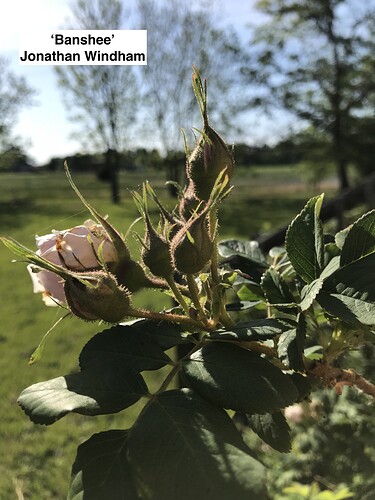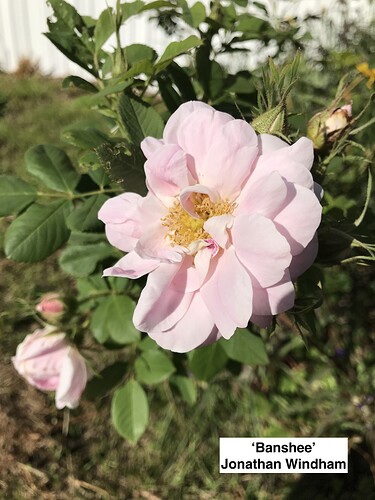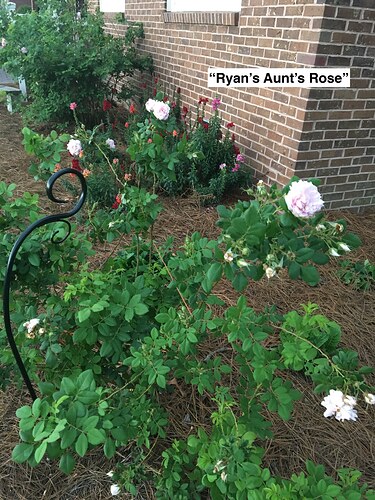For what it’s worth, here are some pics of my Hansa.
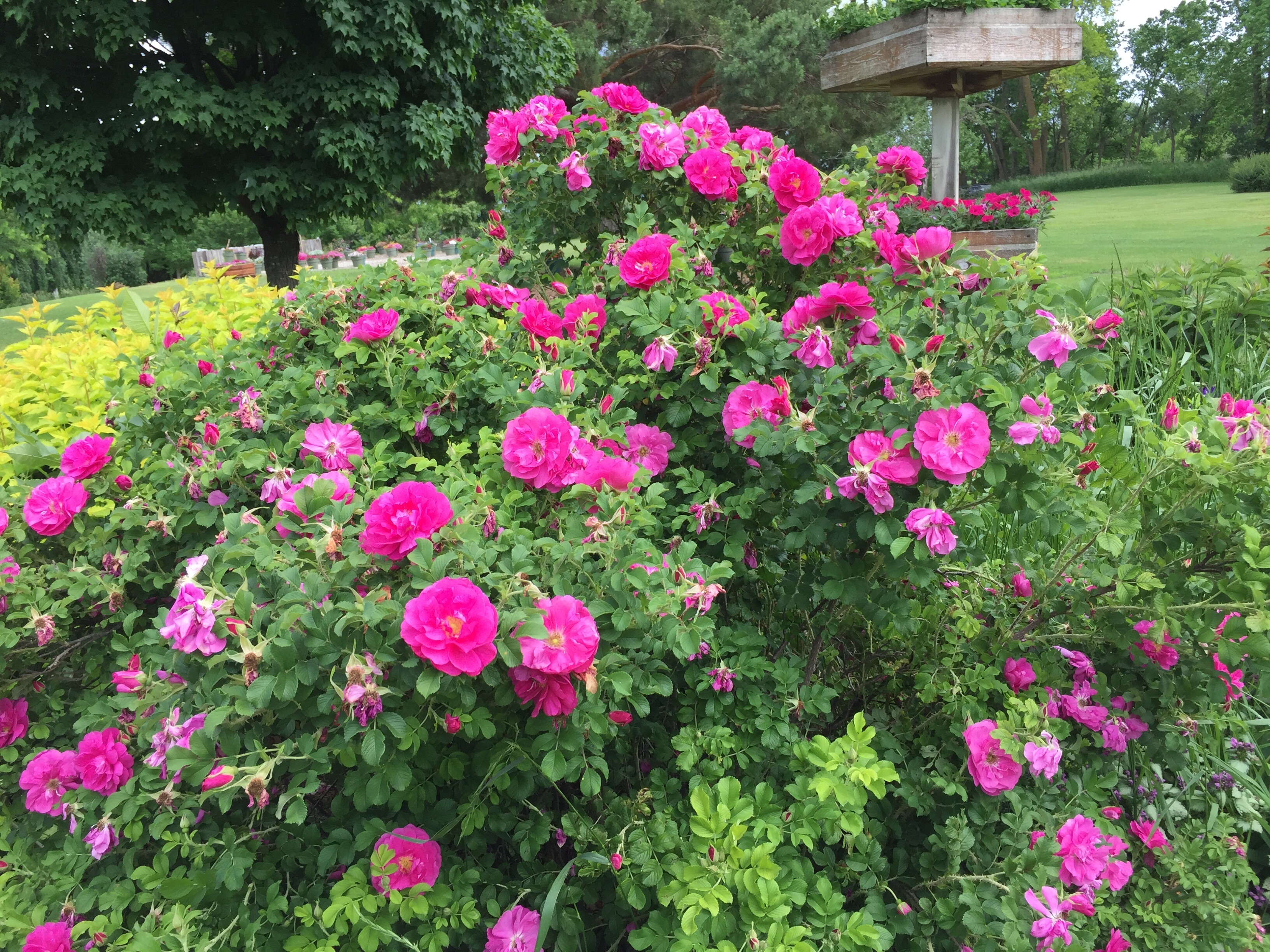
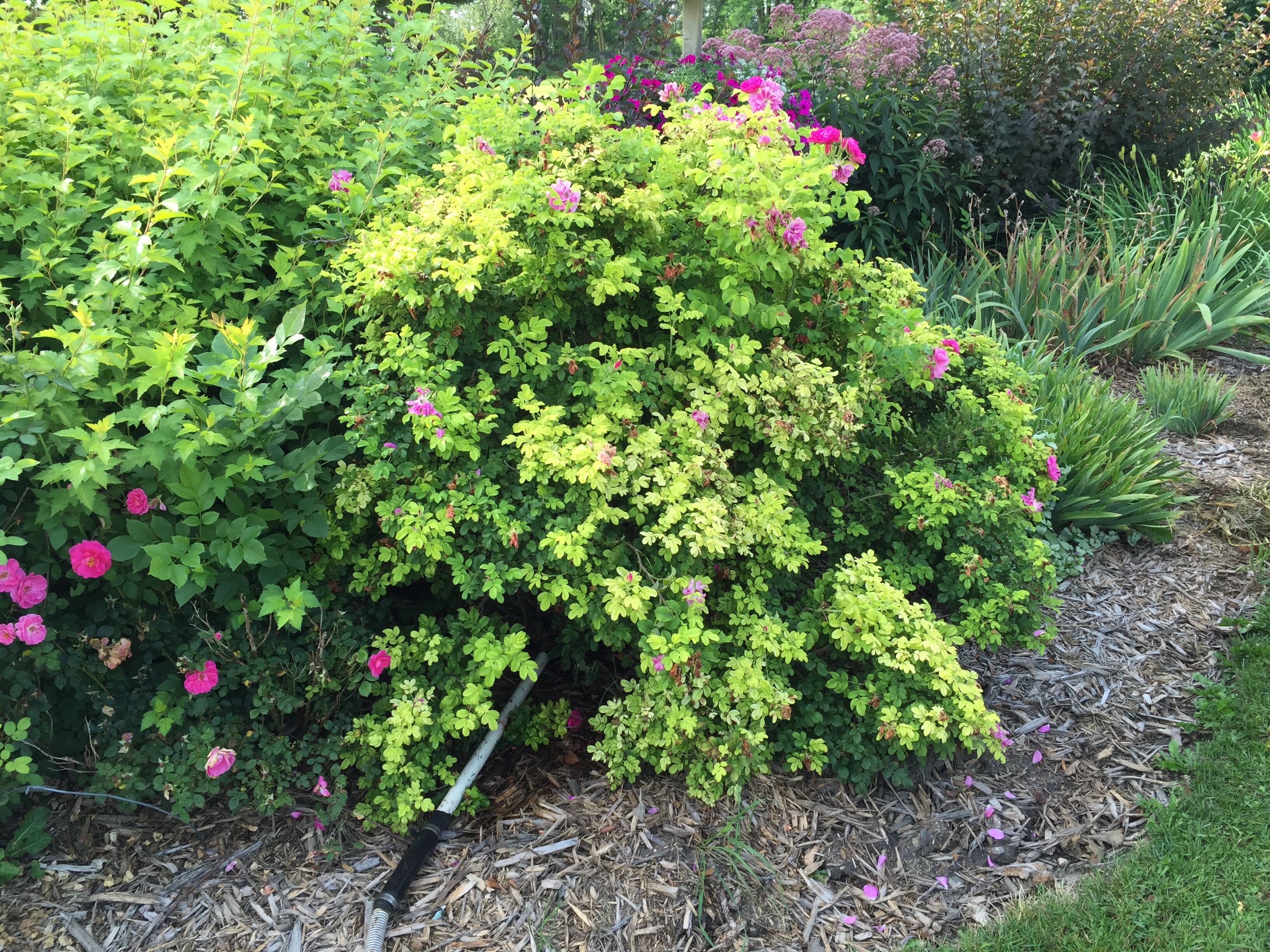

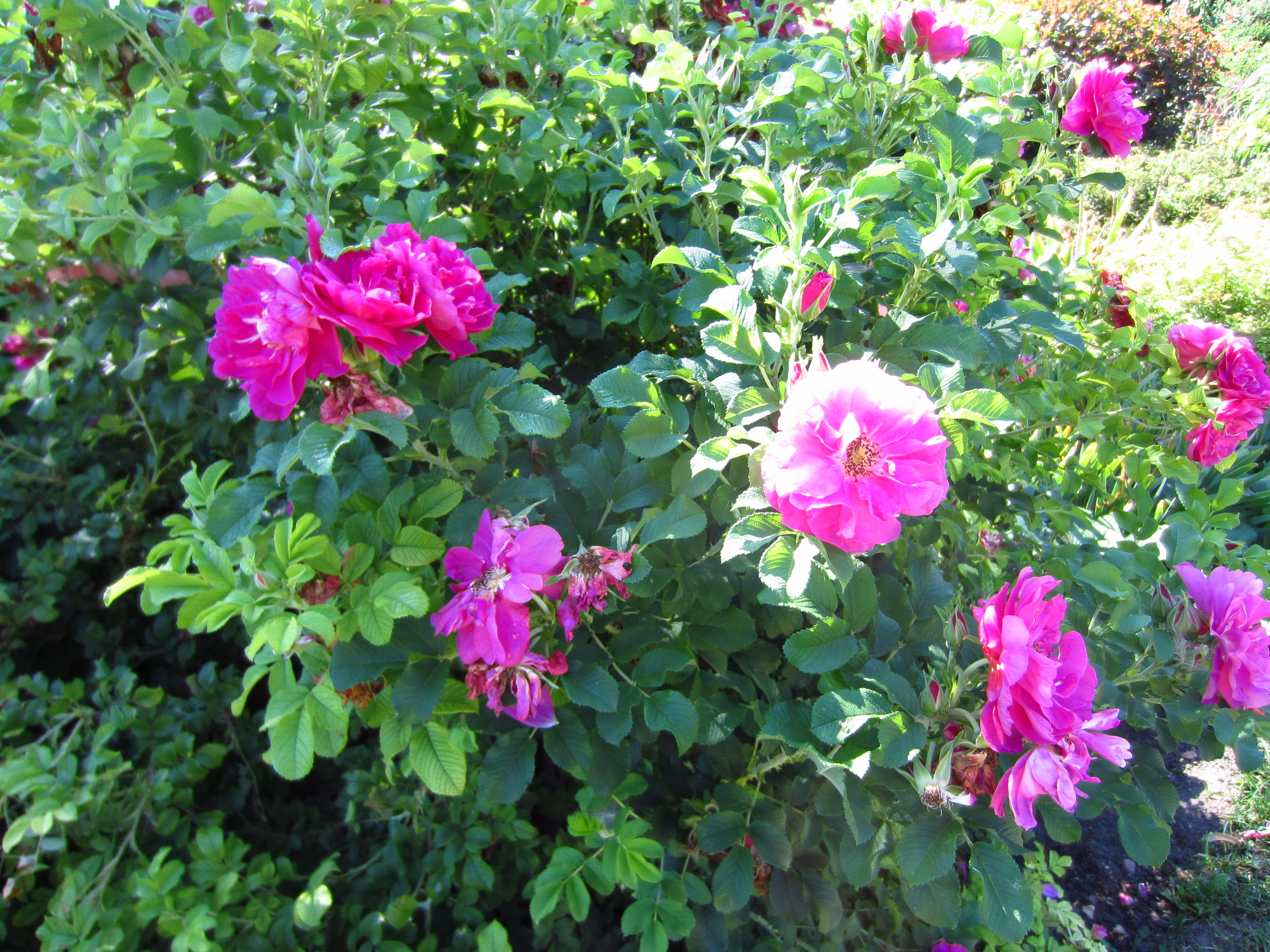
More a believer its “cultivar based” as have a number types of rugosa bed fillers and leaves show to my eyes a healthy green tone … except one for the last 5-10 years, a white, name long lost. It is completely “yellow” every year starting in spring and stays yellow and a “runt” even after annual massive supplement dosing with hosing of leaves.
Soil ph last measured years ago before shredding recycling started, lay to slightly basic side. Btw your Hansa would pass as ok in this garden unless yellow heavier than photo.
I hope you get some more suggestions of nearly or hardy non - rugosa diploids repeaters as l am interested in learning about opportunities as l am tapped in zone3 - 4a … if only my Agathas repeated they would be a primo candidates. One of the reasons besides need for fragrance goal achievement and history, some HPS and Portlands went in this year for pollen donation (sidonie yolande baronne prevost and panachee d Lyon - (sic))
Perpetual anemia ? Today - photo sideways - fencing thwarts those who eat my “Ran” … slightly bitter as a Helenae cross with R. Cinn…

Not to keep on a tangent relative to the thread topic, but there sure are a lot of references to ‘Loyalist Rose’ as another name that has been used for ‘Banshee’, by folks who know the difference between it and the very different ‘Maiden’s Blush’:
One article mentions banshee aka “grandmother’s rose”.
As one for pursuing tenuous coincidences and caused by reading some skinner and wright articles l became interested in a reference to a “Grannie’s rose” by one of them … a stated belief an import of European origins from long ago … apparently migrating from Eastern Canada to them for breeding consideration.
My interest was generated by apparent hardiness history and fragrance.
An Alberta Heritage garden l visited lists it along with a planted sample. Describes it as pink semi double fragrant and non-recurrent.
l had visited the garden awhile back in spring to photo winter cane damage on all the heritage roses - looking for breeding candidate … will now have to see the bloom … it does not have to my amateur eyes my maiden blushes bare structure - but does appear to have semi-hardness characteristics. This digression has been useful as maybe it could be Minette of which a couple - as per nursery label - grow in my garden.
Stark bare bush photo in link below
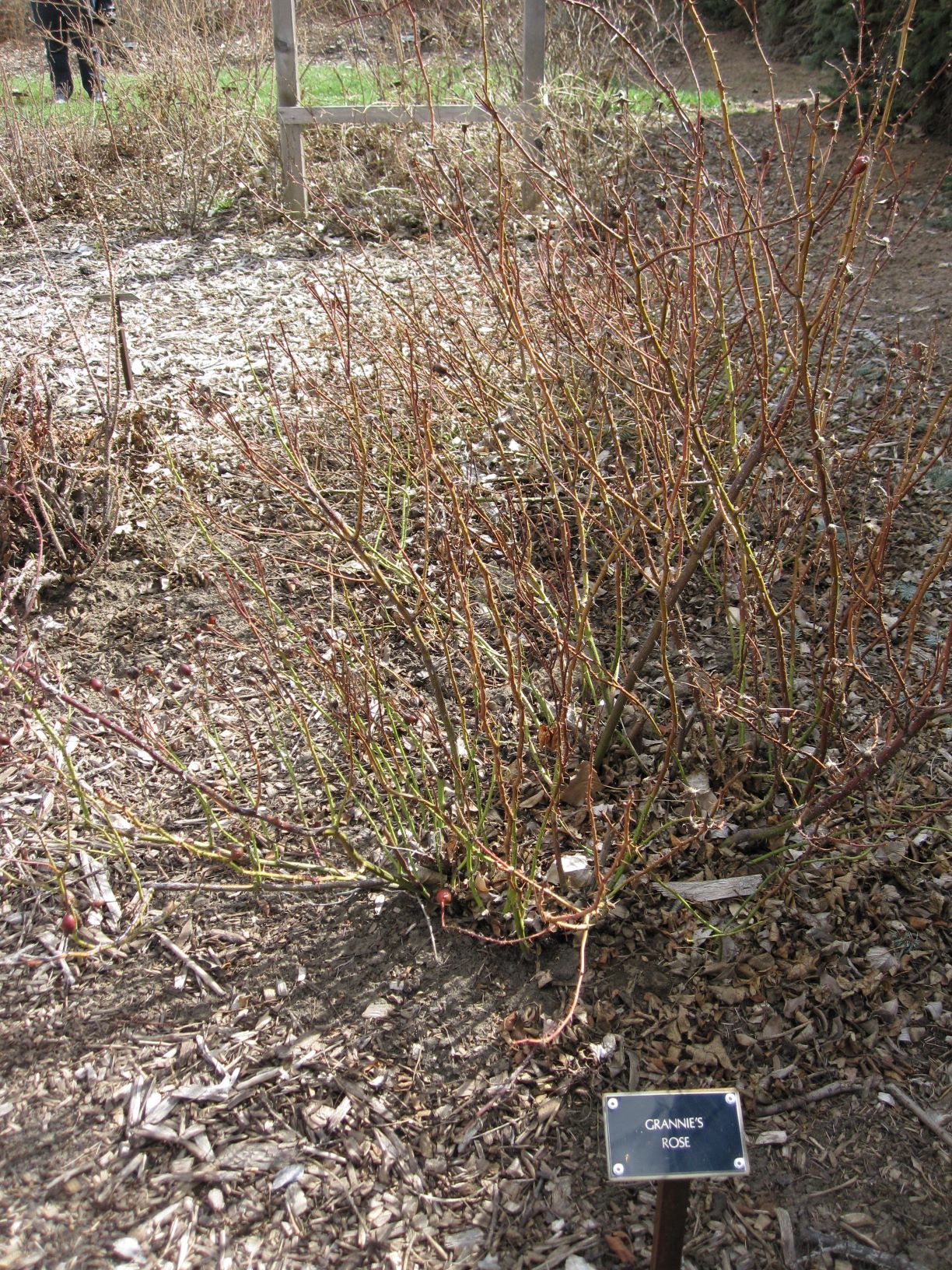
The Loyalist Rose Garden (although it’s a stretch to call it a rose garden since it’s only three, large concrete planters) in Victoria, B.C. is a very good source for the correct identity of the ‘Loyalist Rose’. This rose garden is located on the Causeway of the Inner Harbour of the city, and I’ve personally seen it.
The United Empire Loyalist descendants have documented their history very well and know how this rose came to Canada.
It was brought to western New York in 1773 by the Scottish emigrants, John and Mary Cameron. After the American Revolution they brought it to the Cornwall area of Ontario.
The first paragraph of the plaque at this rose garden reads: The Loyalist Rose is identified in many renaissance plantings as “Maiden’s Blush” of the Rosa alba family. Blooming in June, this densely branched shrub has cupped, very double, fragrant flowers in colours from pale pink to almost white.
Furthermore, the United Empire Loyalists’ Association of Canada published an article entitled Loyalist Plants, which is available online.
“The Loyalist Rose was first planted at Ottawa’s Experimental Farm in May 1998, but under the name of Maiden’s Blush as arranged by Nova Scotian’s.”
In the April 1975 National Geographic, in an article about the United Empire Loyalists. there is a photo of the ‘Loyalist Rose’. Maybe someone could dig it up and report back.
I wonder, though, if the ‘Loyalist Rose’ wasn’t only mistakenly thought to be ‘Maiden’s Blush’, since the two share a similar flower coloration and the latter rose’s name was extremely well known; meanwhile, the rose in question either had no name or if it did, it could easily have been unknown to the Camerons. The Loyalist Rose Garden was likely planted (albeit with good intentions) in 2007 with actual ‘Maiden’s Blush’ rather than genuine ‘Loyalist Rose’/‘Banshee’ plants. There are clearly allusions to Scotland in the history of ‘Banshee’, as well (which couldn’t be much more obvious, with a name like that). Given that it almost certainly is a native American rose by blood, it clearly did not begin life in Europe or Scotland, but there was a long colonial history and it is easy to imagine the rose crisscrossing the Atlantic. Perhaps one of the more colorful Scandinavian names for it, “Svearnas Ros” (swearer’s rose, if I’m not mistaken?), comes from an association with sailors!
It will be interesting to dig more into the known Canadian history as well.
I still think that it is probable that this is what was probably first published as ‘Turneps’ (or the Turnip Rose, less romantically), which also was first written about at the turn of the 19th century and, interestingly enough, when Bosc named it Rosa rapa, he indicated that it was from Scotland. Lindley tore that theory to shreds in his monograph, identifying it as clearly being of North American species descent.
Stefan
Sorry, Riku, I meant to say that the spines and cane coloration of the “Grannie’s Rose” in your last image does look an awful lot like ‘Banshee’, and not at all like ‘Maiden’s Blush’.
Did your ‘Ran’ actually survive the vermin feasting, by the way? That’s a very interesting and somewhat unexpected hybrid, and although it might not be likely, it could possibly carry a recessive mutation for repeat bloom from “Helenae Hybrida”, which I have read can produce seedlings that flower recurrently. If only the latter were available in North America, too. If it didn’t make it, I hope there are still other ‘Ran’ in Canada, at least!
Here, too, is a clear ‘Banshee’ (or ‘Loyalist Rose’, if you prefer):
Hi Stephan,
Really PO’d, as it is history, pulled Ran yesterday after waiting to see if a “new growth” would emerge - unfortunately never got a full hardiness shake (made it through one winter on second). I was my own worst enemy and under-designed the first “Snowy Aussie Rabbit” fence making it too low by forgetting to account that piled snow makes a great ramp to hop over the fence and bunnies grow up to be big Bstds. A 3 footer went up around the front plots this spring except where esthetics dictate. Ruth, Ormiston Roy, Alysham and Emily Carr also got it but are bouncing back nicely.
But all is not lost as nice assortment Helenae, seedlings and hybrids went in with the Fin gallicas and spinos roses … really impressed this spring with the vigor of new plants especially Lens’ Red Robin (helenae hybrid) … as to hardy for latter … not likely … but that’s for peat moss to solve.
Caged the priceless, protected and spring cloched the Red Dawn (no hardiness whats so ever for me) which is in the rabbit vulnerable plot - will bloom for the first time in 3 or 4 years due to extensive winter protection - 18 inches of a peat moss tower. Red Dawn x Suzanne has given stellar winter performance for years … would of loved credit for that cross … so what happened down the road to the hardiness of it when its offspring need shearing in spring in my garden ? … having a sarcastic moment, should temper myself as the hybridizers have achieved more than I have so far.
‘Grannie’s Rose’ growing at the Brooks, Alberta rose garden is likely a Damask rose. It definitely isn’t ‘Minette’ or ‘Banshee’. Healthy, vigorous, fragrant and good cold hardiness for a Zone 3 climate. I certainly would use it in a breeding program.
Correction, RAN made it through 2 winters, including 19’s where Febs day time temperature never were not above -25C and -30C common … enough to chase you DEEP done south to recover in an island.
Definitely have to find somebody willing to part with a “Grannie’s Rose” with impeccable Provenance, or lame horse trade for a sketchy Provenance :-)).
Joe, when doe the breeding season end for your virginiana hybrids?
That photo of Riku’s looks like a ‘Banshee’ (or other native rose hybrid) to me–the large, paired prickles restricted mainly to the nodes give it away. Damask roses, like other R. gallica-based OGRs, will display a mix of prickles in different sizes all around the canes with little clear pattern. They won’t be mainly seen paired at the nodes. Also, there are no Damask roses that are truly cane-hardy in zone 3.
Perhaps I can shed some light on this:
In 2016, I shared my plant of ‘Banshee’ with Texas A&M and asked if they would do a ploidy count. Ellen Roundey (now Ellen Young) did the count for me and she determined that the plant was tetraploid.
From Ellen (Aug. 22, 2016):
“Jonathan,
A while (okay, a long time) ago you asked for the ploidy of ‘Banshee’. I don’t know if you still need the information, but we finally counted it and it appears to be a tetraploid. I’ve attached a cell phone photo of one of the better chromosome spreads (near tip of pointer). Thank you for all your help on this project!
Ellen Roundey”
Recently, David Zlesak performed ploidy counts on plants of ‘Minette’ from Paul Olsen and of ‘Banshee’ from myself. The ploidy counts revealed that what Paul grows as ‘Minette’ is diploid. The plant that I grow as ‘Banshee’ is tetraploid.
Paul writes:
I found my plant of ‘Banshee’ growing beside the road in Lamar, South Carolina in 2014. It was identified for me by Paul Barden and I agree with his ID. It always baffled me as to how an obscure, commercially unavailable rose found its way to such a small, small, rural town. I believe this question was answered when the local botanical gardens, Kalmia Gardens in Hartsville (not far from Lamar), asked me to identify a rose they grow as “Ryan’s Aunt’s Rose”. I identified their mystery rose as ‘Banshee’, as it was identical to my plant. It turns out, “Ryan’s Aunt’s Rose” belonged to the aunt of Ryan Gainey, the late internationally renowned garden designer who was originally from Hartsville, SC. I believe that Ryan is responsible for bringing this rose to my area and I feel confident that the plant I found beside the road is an escaped piece of one of his ‘Banshee’ plants.
Photos of my plant:
-Jonathan
Don, I suppose some time in late June or early July. Probably only a few buds showing at this time.
… as lan McShane’s “BBC Lovejoy antiques divy” character” would say “Oh its the real thing alright” … thanks for taking the time to fill in the ploidy facts and provenance trail info with only a minor jump in origins
Jonathan, thank you very much for taking the time to carefully lay out the background on your ‘Banshee’ and its use in the Texas A&M chromosome count (do you happen to know if flow cytometry or root tip squash were used?). I agree that your plant fits into the ‘Banshee’ mold nicely.
Paul, do you happen to have (or might it be possible to take) any photos of the plant that you sent to David Z. under the name ‘Minette’?
I’ve grown two slightly different ‘Banshee’ myself; the first was from a very small, rural, specialty nursery deep in swampy southern Louisiana. The second was sold misidentified as ‘Rose d’Amour’ by Brentwood Bay Nurseries in BC, Canada, but proved to be a form of ‘Banshee’. I am hoping to make a closer, more careful comparison of the two soon. One thing is clear–the adaptability of the ‘Banshee’ complex to extremes of cold, heat, humidity, and soil moisture is remarkable. Even with their frequent balling problems, Paul is absolutely correct, they deserve to be explored more in breeding work.
Given that it was already known or suspected that there are different ‘Banshee’ clones, it might also not be entirely out of the question for them to have different ploidies as well, although that would still be quite an interesting result. Knowing the chromosome numbers for the clones at large would help breeders, and that might also help us to identify and ultimately apply individual names to the different clones to help keep them separate. Those should be unambiguous and unique to avoid further confusion.
Stefan
Getting back to the original topic, have you tried the plant that is being sold as ‘Mountain Mignonette’ (so named and originally sold by High Country Roses, I believe)? They claim that it is hardy to zone 4, and hardier than ‘Mignonette’, although it isn’t clear whether that is a measure of cane hardiness or just good post-winter recovery.
MidAtlas1,
‘Grannie’s Rose’ growing at the Brooks, Alberta rose garden - I’ve seen it flowering several times over a period of four decades. Again, it’s definitely not ‘Banshee’ or “another native rose hybrid.” Also, I never said it was cold hardy to a Zone 3 climate but rather that it has “good cold hardiness” to one. I’ve never seen it with substantial winter kill and it appears the shrub flowers consistently from year to year.
You’re fixated about the genetics of ‘Banshee’ or on roses you have concluded or might be ‘Banshee’ based a lot on speculation. You also make illogical statements and come to conclusions without any evidence. For example, what does it matter if a ‘Maiden’s Blush’ was planted at the Loyalist Rose Garden in Victoria as the ‘Loyalist Rose’, since the United Empire Loyalists organization has always known it to be the same rose. However, to you this is problematic (it’s not though) and then emphatically state the ‘Loyalist Rose’ is ‘Banshee’. Huh?
Riku,
For a few years I have been working with the VanDusen Botanical Garden in Vancouver to establish a Canadian heritage rose garden. Perhaps this year will be the first plantings.
I would like to see a section of the garden having roses not developed in Canada but were grown by early Canadian settlers. Roses like ‘Banshee’, ‘Minette’, ‘Indian Head’, ‘Grannie’s Rose’, and Rosa centifolia, for example. The propagation of the roses for this garden is done in Vancouver. The 2019 inventory indicated four plants of ‘Grannie’s Rose’ (from cuttings taken at Brooks). We only need one plant, of course, so you may be in luck to get one.
Paul
